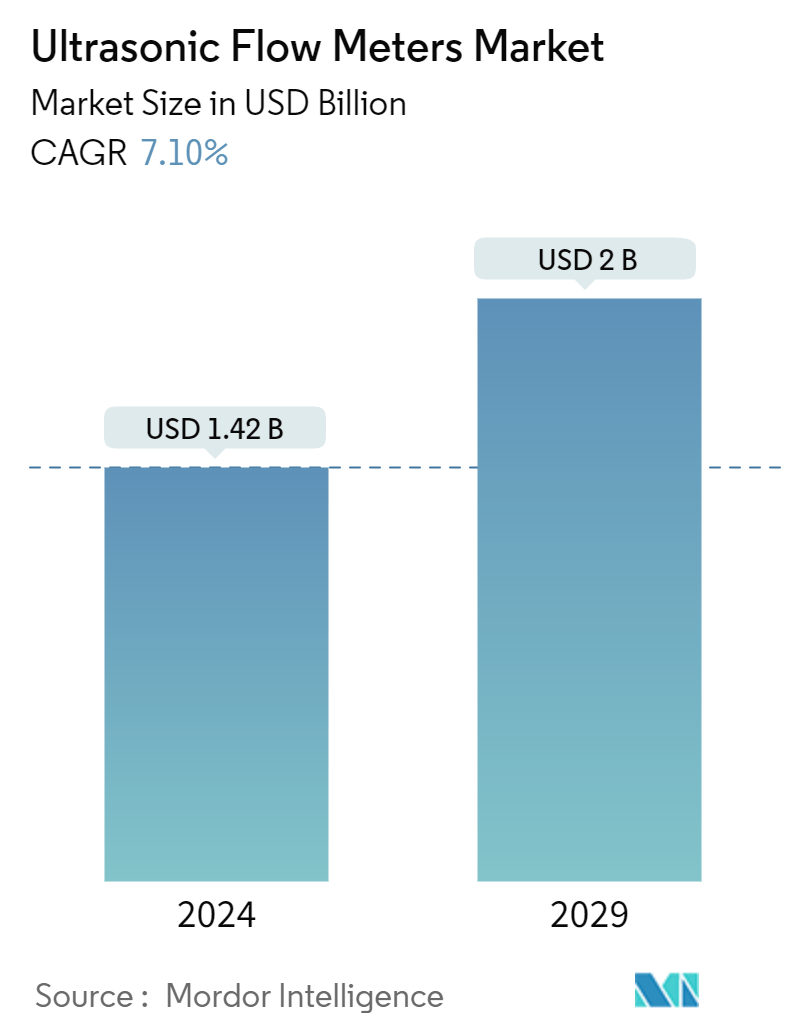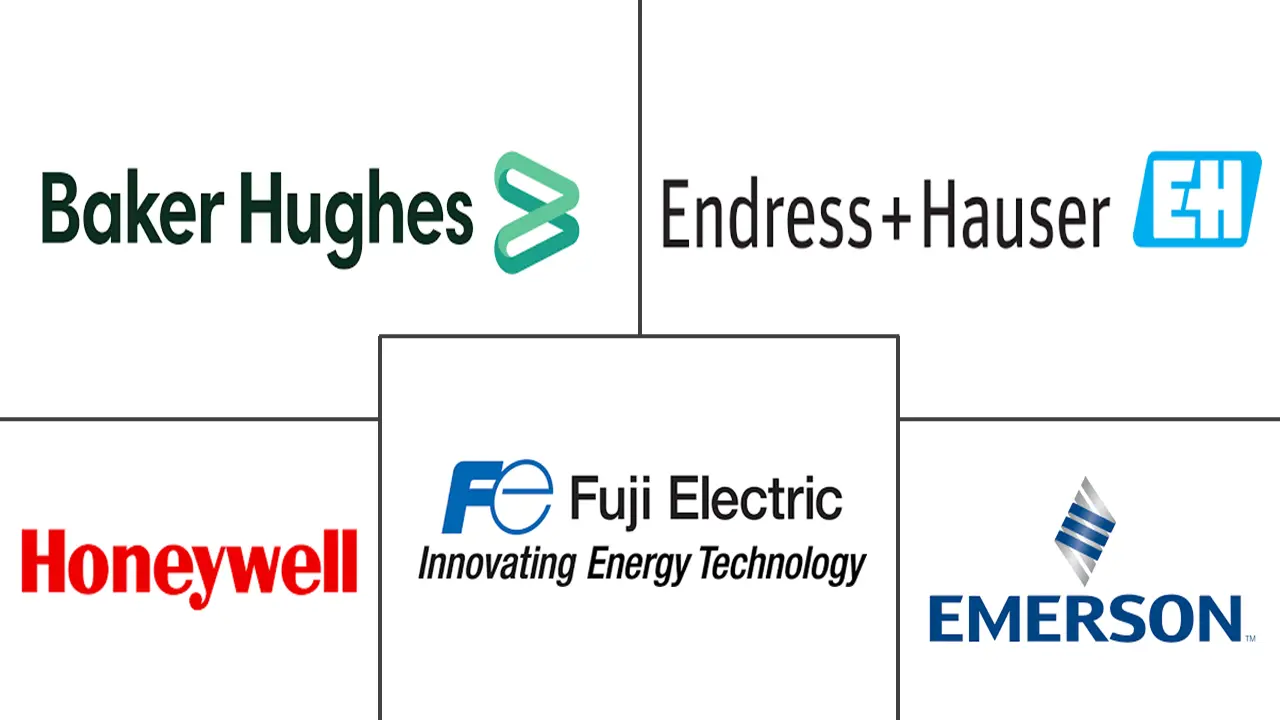Market Size of Ultrasonic Flow Meters Industry

| Study Period | 2019 - 2029 |
| Market Size (2024) | USD 1.42 Billion |
| Market Size (2029) | USD 2 Billion |
| CAGR (2024 - 2029) | 7.10 % |
| Fastest Growing Market | Asia Pacific |
| Largest Market | Asia Pacific |
Major Players
*Disclaimer: Major Players sorted in no particular order |
Ultrasonic Flow Meters Market Analysis
The Ultrasonic Flow Meters Market size is estimated at USD 1.42 billion in 2024, and is expected to reach USD 2 billion by 2029, at a CAGR of 7.10% during the forecast period (2024-2029). In terms of shipment volume, the market is expected to grow from 418.30 thousand units in 2024 to 589.40 thousand units by 2029, at a CAGR of 7.10% during the forecast period (2024-2029).
Ultrasonic flow meters are devices that measure the velocity of a fluid flowing through a pipe using ultrasonic technology. They operate by emitting sound waves and analyzing the time it takes for these waves to travel through the fluid. This technology allows for accurate flow measurement without the need for moving parts, making them reliable and maintenance-free.
- Ultrasonic flow meters are known for their high accuracy, often achieving measurement uncertainties of less than ±1% of the reading. This level of precision is crucial in industries such as water treatment, oil and gas, and pharmaceuticals, where accurate flow measurement is essential for process control and regulatory compliance. The reliability of these meters is further enhanced by their ability to operate consistently across a wide range of conditions, including varying temperatures and pressures.
- Ultrasonic flow meters can be utilized for various applications, including clean water, wastewater, chemicals, and even gases. Their versatility makes them suitable for a wide array of industries, such as food and beverage, HVAC, and manufacturing. This adaptability allows companies to standardize their measurement processes across different operations, simplifying training and maintenance.
- Ultrasonic flow meters utilize sound waves to measure the flow rate of liquids and gases. They operate on the principle of transmitting ultrasonic signals through the medium and measuring the time it takes for the signals to travel between transducers. The difference in transit time between upstream and downstream signals is used to calculate the flow velocity, which can then be converted into flow rate.
- Safety is paramount in industries such as oil and gas, chemical processing, and pharmaceuticals. Non-invasive flow measurement reduces the risk of leaks and spills associated with traditional measurement methods that require invasive probes or fittings. By eliminating the need for physical contact with hazardous materials, these technologies enhance workplace safety and reduce the likelihood of accidents, aligning with regulatory risk management requirements.
- The ongoing geopolitical concerns in the Middle East hinder the region's market growth as countries mainly invest in defense and military expenditure. Further, increased inflation and economic slowdown restrict the consumer purchasing power in the region, which is expected to impact market growth negatively. For instance, In MENA, Iran led with the highest inflation rate, which increased by 41.5% in 2023 compared to 2022. Following it, Egypt, Algeria, Tunisia, and Morrocco witnessed a significant increase in the inflation rate in 2023.
Ultrasonic Flow Meters Industry Segmentation
Ultrasonic flow meters are devices that measure the velocity of a fluid flowing through a pipe using ultrasonic technology. They operate by emitting sound waves and analyzing the time it takes for these waves to travel through the fluid. This technology allows for accurate flow measurement without the need for moving parts, making them reliable and maintenance-free. The study monitors the revenue generated by the sales of ultrasonic flow meters globally.
The ultrasonic flow meter market is segmented by mounting method (clamp-on and in-line), end-user industry (oil and gas, water and wastewater, chemical and petrochemical, industrial (F&B, aerospace, and automotive), other end-user industries (life sciences, mining and metals, etc.)), and geography (North America, Europe, Asia-Pacific, Latin America, and Middle East and Africa). The market sizes and forecasts are provided in terms of value in USD for all the above segments.
| By Mounting Method | |
| Clamp-on | |
| In-line |
| By End-User Industry | |
| Oil and Gas | |
| Water and Wastewater | |
| Chemical and Petrochemical | |
| Industrial (F&B, Aerospace, and Automotive) | |
| Other End-user Industries (Life Sciences, Mining and Metals, etc.) |
| By Geography*** | |
| North America | |
| Europe | |
| Asia | |
| Australia and New Zealand | |
| Latin America | |
| Middle East and Africa |
Ultrasonic Flow Meters Market Size Summary
The Ultrasonic Flow Meter market is experiencing significant growth, driven by advancements in technology and increasing demand across various industries. Initially developed for medical applications, ultrasonic flow meters have evolved to serve industrial purposes, particularly in water and wastewater management. The introduction of time-of-flight technology in the 1990s expanded their use in waste and clean water sectors. Non-intrusive measurement methods, such as the Clamp-on technique, have further enhanced their applicability in industries like oil and gas, chemicals, and food and beverage, allowing for seamless flow measurement without disrupting operations. The market is characterized by continuous technological innovations, including the integration of sophisticated sensors and microprocessors, which are improving the accuracy and efficiency of flow measurement solutions.
The market landscape is highly competitive, with numerous vendors offering a range of ultrasonic flow meters tailored to different industrial needs. Key players such as Baker Hughes, Endress+Hauser, Honeywell, and Emerson Electric are prominent in the market, providing solutions that cater to various media pressures, temperatures, and construction materials. The COVID-19 pandemic has also positively impacted the market, as the need for safe water supply and wastewater management has become more critical. Regions like Asia-Pacific are witnessing rapid urbanization, driving the demand for efficient water and wastewater treatment solutions. The market's growth is further supported by strategic collaborations and product launches aimed at enhancing measurement accuracy and expanding application ranges, ensuring the continued adoption of ultrasonic flow meters across diverse sectors.
Ultrasonic Flow Meters Market Size - Table of Contents
-
1. MARKET INSIGHTS
-
1.1 Market Overview
-
1.2 Industry Attractiveness - Porter's Five Forces Analysis
-
1.2.1 Bargaining Power of Suppliers
-
1.2.2 Bargaining Power of Buyers
-
1.2.3 Threat of New Entrants
-
1.2.4 Threat of Substitutes
-
1.2.5 Intensity of Competitive Rivalry
-
-
1.3 Analysis of Key Measuring Technology
-
1.4 Impact of COVID-19 Aftereffects and Other Macroeconomic Factors on the Market
-
1.5 Analysis of Trends and Dynamics of IoT-enabled Ultrasonic Flow Meters
-
-
2. MARKET SEGMENTATION
-
2.1 By Mounting Method
-
2.1.1 Clamp-on
-
2.1.2 In-line
-
-
2.2 By End-User Industry
-
2.2.1 Oil and Gas
-
2.2.2 Water and Wastewater
-
2.2.3 Chemical and Petrochemical
-
2.2.4 Industrial (F&B, Aerospace, and Automotive)
-
2.2.5 Other End-user Industries (Life Sciences, Mining and Metals, etc.)
-
-
2.3 By Geography***
-
2.3.1 North America
-
2.3.2 Europe
-
2.3.3 Asia
-
2.3.4 Australia and New Zealand
-
2.3.5 Latin America
-
2.3.6 Middle East and Africa
-
-
Ultrasonic Flow Meters Market Size FAQs
How big is the Ultrasonic Flow Meters Market?
The Ultrasonic Flow Meters Market size is expected to reach USD 1.42 billion in 2024 and grow at a CAGR of 7.10% to reach USD 2 billion by 2029.
What is the current Ultrasonic Flow Meters Market size?
In 2024, the Ultrasonic Flow Meters Market size is expected to reach USD 1.42 billion.

